If you love blooms but have limited space, dwarf flowering trees are the perfect solution. These compact trees bring bursts of color, fragrance, and life to patios, courtyards, and small yards — without outgrowing their space. Here are some of the most beautiful options to inspire your next garden upgrade.
15 Best Dwarf Flowering Trees for Small Gardens
1. Dwarf Magnolia (Magnolia grandiflora ‘Little Gem’)
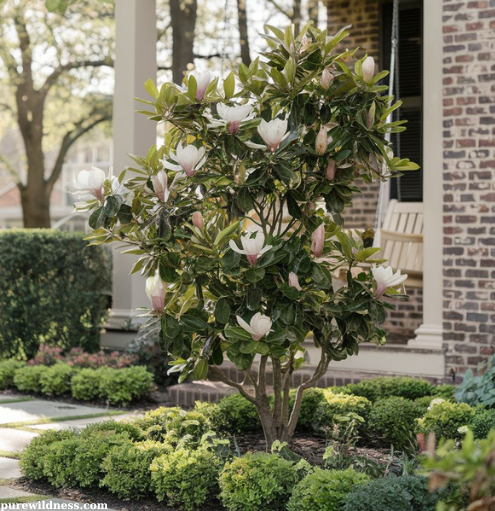
If you love the iconic southern magnolia but don’t have space for a towering tree, the “Little Gem” variety is one of the finest dwarf flowering trees to grow. Native to the southeastern U.S., this compact evergreen beauty reaches about 15–20 feet tall and 7–10 feet wide, perfect for urban landscapes, small gardens, or patios. Its glossy green leaves have bronze undersides that shimmer in sunlight, while the large creamy-white blossoms release a sweet lemon scent from late spring through summer.
This tree thrives in full sun to part shade and prefers slightly acidic, well-drained soil. It’s slow-growing but long-lived, rewarding gardeners with timeless southern charm in a manageable size. Once established, “Little Gem” is fairly drought-tolerant and requires minimal pruning. Elegant, fragrant, and evergreen, it’s one of the most beloved dwarf flowering trees for bringing a touch of grandeur to cozy spaces.
2. Dwarf Crape Myrtle (Lagerstroemia indica dwarf cultivars)
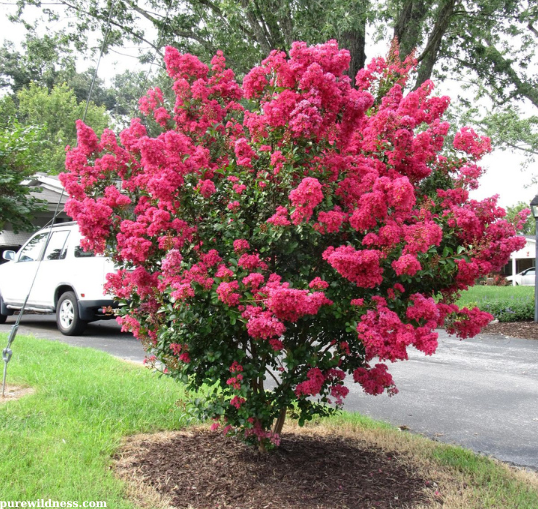
Compact and endlessly colorful, dwarf crape myrtles are true gems among dwarf flowering trees. Native to Asia and adored across the American South, these trees typically stay 6–12 feet tall and produce clusters of crepe-paper-like flowers in pink, purple, red, or white from mid-summer into fall. Their smooth, peeling bark and glossy foliage keep them attractive even in winter.
These hardy little trees love full sun and well-drained soil and are remarkably drought-tolerant once established. Dwarf varieties like ‘Pokomoke’ or ‘Chickasaw’ are ideal for containers, small yards, or lining driveways. In addition to their vivid color and long blooming period, they resist mildew better than older cultivars. Easy-care and heat-loving, dwarf crape myrtles deliver maximum flower power with minimal fuss—making them among the best dwarf flowering trees for southern gardens.
3. Weeping Dwarf Cherry (Prunus × yedoensis ‘Shidare-Yoshino’)
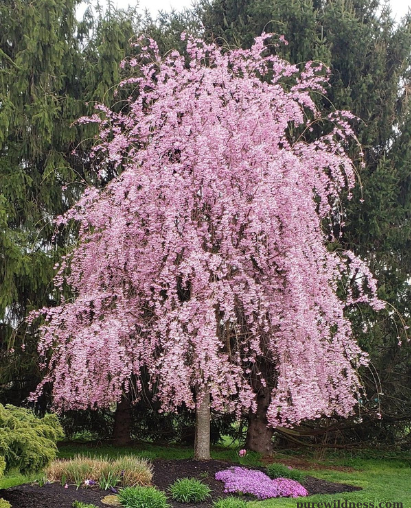
Few sights rival the graceful beauty of a weeping dwarf cherry in bloom. This compact tree, typically 8–12 feet tall, is prized for its arching branches that overflow with clouds of soft pink or white flowers each spring. Native to Japan, it thrives in USDA zones 5–8 and prefers full sun with moist, well-drained soil.
In early spring, it transforms bare branches into delicate cascades of petals that flutter like snow in the breeze. Its leaves emerge bright green, turning golden-orange in autumn before falling. While it prefers consistent moisture, it’s not overly demanding—just avoid soggy soil. Perfect as a centerpiece in small yards or near patios, this weeping cherry brings drama, romance, and four-season appeal. Among dwarf flowering trees, few can match its graceful silhouette and breathtaking spring display.
4. Dwarf Pomegranate (Punica granatum ‘Nana’)

Brilliant, compact, and bursting with life, the Dwarf Pomegranate is one of the most colorful dwarf flowering trees for warm climates. Native to the Middle East and South Asia, this miniature tree grows 3–4 feet tall and wide, thriving in full sun and well-drained soil. It’s a perfect fit for USDA zones 7–11, where it can flower almost continuously from late spring to early fall.
The trumpet-shaped, orange-red blossoms glow against glossy green leaves, often followed by tiny ornamental fruits that resemble miniature pomegranates. Though edible, they’re mainly decorative. This tough little tree tolerates drought, heat, and even poor soil once established.
Perfect for Mediterranean gardens or bright patios, it brings fiery color and a sense of vitality to any small landscape. The Dwarf Pomegranate proves that even the tiniest of dwarf flowering trees can deliver huge visual impact.
5. Dwarf Redbud (Cercis canadensis ‘Ace of Hearts’)
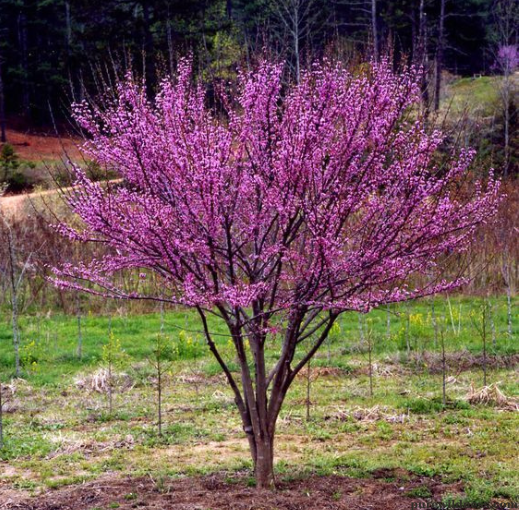
For springtime magic in miniature form, look no further than the Dwarf Redbud. Native to North America, ‘Ace of Hearts’ grows just 9–12 feet tall with a compact, rounded canopy. In early spring, before the leaves appear, its bare branches are covered in clusters of rosy-pink blossoms that attract bees and butterflies.
Once the blooms fade, heart-shaped leaves emerge in bright green, later deepening into a lush summer canopy and turning golden in fall. This small tree thrives in full sun to partial shade and adapts to a wide range of soils, preferring well-drained conditions. It’s hardy, low-maintenance, and adds vibrant early-season color to gardens of any size. With its charm, compact size, and four-season appeal, the Dwarf Redbud is one of the most cherished dwarf flowering trees in American landscapes.
6. Dwarf Bottlebrush (Callistemon citrinus ‘Little John’)
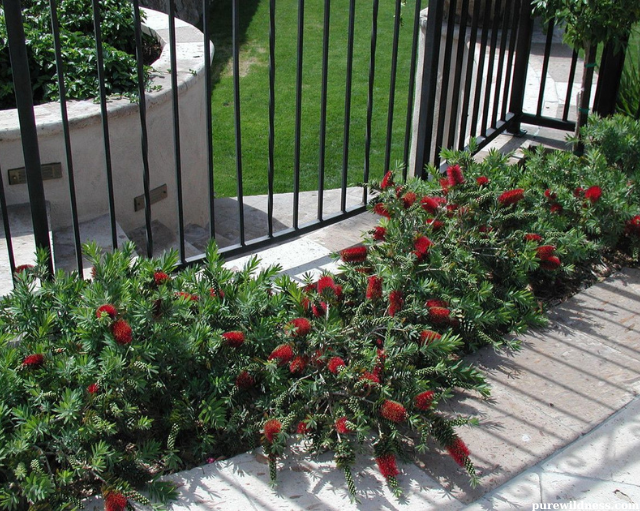
For gardeners seeking vibrant color and hummingbird magnetism, the Dwarf Bottlebrush is a standout among dwarf flowering trees. Native to Australia, this compact evergreen beauty grows only 3–5 feet tall and 4–6 feet wide, forming a rounded, dense shape that looks stunning in small yards or containers. Its bright crimson-red, brush-like blooms appear from spring through fall, glowing vividly against narrow, bluish-green leaves.
Thriving best in full sun and well-drained soil, it loves warm climates and fits perfectly in USDA zones 8–11. Once established, it’s drought-tolerant, deer-resistant, and low-maintenance. Pruning lightly after flowering helps keep its compact form. Whether you plant it along a pathway, in a courtyard, or near a patio, ‘Little John’ provides year-round greenery and brilliant bursts of color that few dwarf flowering trees can rival.
7. Dwarf Jacaranda (Jacaranda mimosifolia ‘Bonsai Blue’)

If you dream of the iconic purple Jacaranda but don’t have space for a full-size version, meet the ‘Bonsai Blue’, a compact marvel among dwarf flowering trees. This tree grows just 8–10 feet tall, offering all the stunning lavender-purple trumpet blooms of its larger cousins in a perfectly scaled-down form. Native to South America, it thrives in USDA zones 9–11, preferring full sun and well-drained soil.
Blooming from late spring through summer, it creates a breathtaking canopy of violet-blue flowers that attract bees and butterflies. Its delicate fern-like foliage adds soft texture even when not in bloom. Perfect for small gardens, patios, or tropical landscapes, the Dwarf Jacaranda brings exotic charm without overwhelming your space. With its manageable height and dazzling display, ‘Bonsai Blue’ earns its place among the most enchanting dwarf flowering trees in any warm-climate garden.
8. Dwarf Korean Lilac (Syringa meyeri ‘Palibin’)
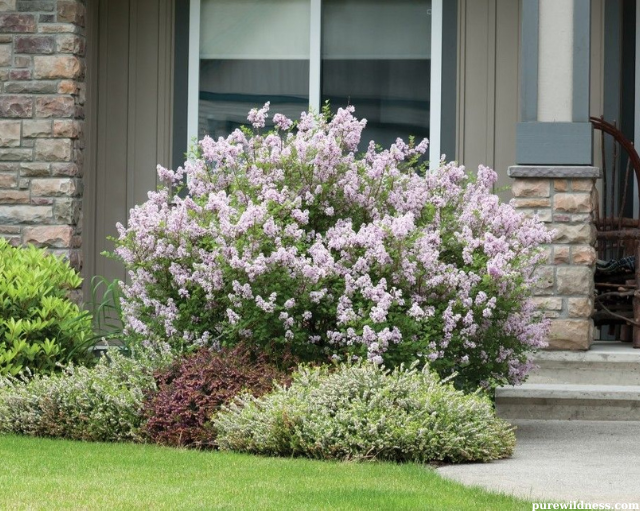
Few dwarf flowering trees deliver fragrance like the Dwarf Korean Lilac. Native to East Asia, this charming shrub-tree hybrid grows about 4–7 feet tall and wide, making it ideal for borders, courtyards, and small front yards. In late spring, it bursts into clusters of lavender-pink blossoms with an intoxicating sweet scent that perfumes the air for weeks.
It thrives in full sun, well-drained soil, and cool to moderate climates (USDA zones 3–7). The dark green leaves remain attractive through summer, turning yellow in fall before dropping. This lilac is hardy, low-maintenance, and deer-resistant, making it a dependable choice for northern gardeners. After flowering, prune lightly to maintain its neat, rounded form. With its combination of compact size, fragrance, and resilience, the Dwarf Korean Lilac is one of the most beloved and easygoing dwarf flowering trees for temperate landscapes.
9. Dwarf Magnolia ‘Teddy Bear’ (Magnolia grandiflora ‘Teddy Bear’)
For those who love lush southern charm, the ‘Teddy Bear’ Magnolia is another elegant option among dwarf flowering trees. Native to the southeastern U.S., this evergreen tree grows 15–20 feet tall but maintains a narrow, upright habit—perfect for tight spaces or small gardens. It features glossy dark green leaves with soft, fuzzy brown undersides (hence the name “Teddy Bear”) and large creamy-white, fragrant flowers that bloom from late spring into summer.
It thrives in full sun to partial shade and prefers slightly acidic, well-drained soil. Once established, it’s heat- and drought-tolerant, requiring minimal care. Ideal for southern landscapes or as an accent tree near entryways, ‘Teddy Bear’ offers a mix of fragrance, texture, and year-round beauty. Among dwarf flowering trees, it’s one of the most regal and refined evergreens you can plant.
10. Dwarf Tibouchina (Tibouchina urvilleana ‘Jules’)
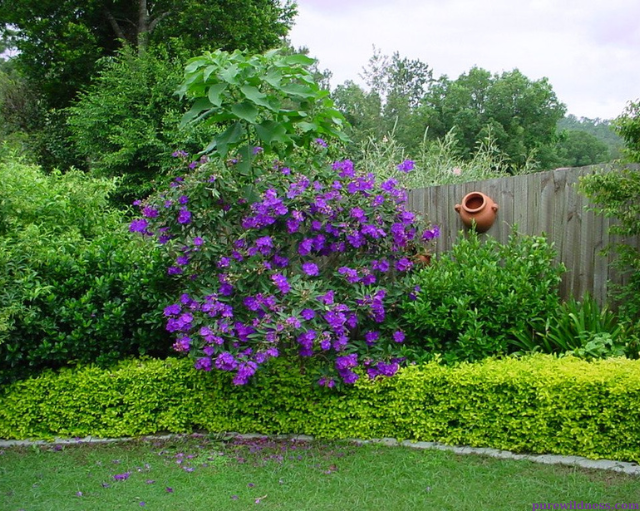
Bring tropical flair to your garden with the Dwarf Tibouchina, known for its velvety purple flowers that bloom almost year-round in warm regions. Native to Brazil, this compact evergreen grows 3–6 feet tall and wide, making it a stunning focal point in USDA zones 9–11. Its deep-green, fuzzy leaves highlight the vivid royal-purple blooms that appear from spring through fall.
Thriving in full sun to light shade, it prefers moist, well-drained soil and regular watering during dry spells. Though frost-sensitive, it can be grown in containers and brought indoors during winter in cooler climates. With minimal pruning, it forms a dense, rounded shape. The Dwarf Tibouchina’s vibrant color and soft foliage make it one of the most eye-catching dwarf flowering trees for tropical and subtropical landscapes.
11. Dwarf Japanese Maple (Acer palmatum ‘Red Dragon’)
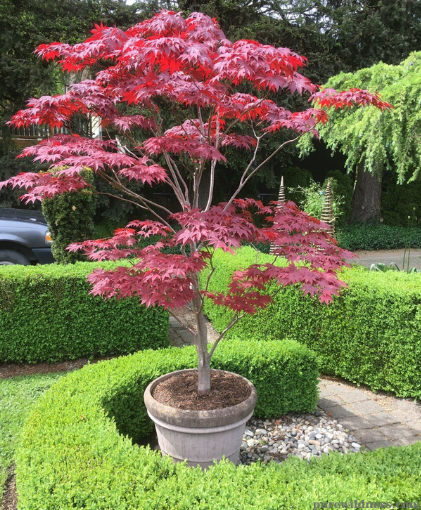
If you want elegance in miniature form, the Dwarf Japanese Maple ‘Red Dragon’ is one of the most striking dwarf flowering trees you can grow. Native to Japan and Korea, this compact beauty reaches about 6–8 feet tall and forms a graceful, weeping mound of finely divided, deep red leaves that glow through the seasons. Although not a heavy bloomer, its tiny spring flowers and spectacular foliage make it unforgettable.
Thriving in partial shade to full sun, it prefers moist, well-drained soil and benefits from protection against harsh afternoon sun in hot climates. The leaves turn brilliant crimson and scarlet in fall, adding fiery color before they drop. Ideal for small gardens, courtyards, or bonsai-style containers, ‘Red Dragon’ delivers year-round texture and artistry. Among dwarf flowering trees, it stands out not for blooms but for its breathtaking foliage performance.
12. Dwarf Chaste Tree (Vitex agnus-castus ‘Blue Diddley’)
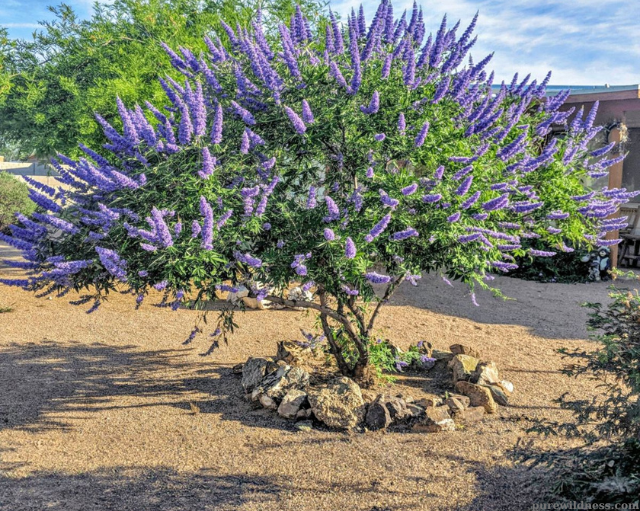
Compact, aromatic, and covered in lavender-blue flower spikes, the ‘Blue Diddley’ Chaste Tree adds a Mediterranean touch to warm gardens. This dwarf version grows 3–6 feet tall, far smaller than its full-size cousin, making it a superb choice for tight spaces or borders. Blooming from late spring through summer, it attracts bees, butterflies, and hummingbirds with its sweet-scented blossoms.
Native to southern Europe and western Asia, it thrives in full sun and well-drained soil, showing strong drought tolerance once mature. The gray-green foliage releases a pleasant herbal aroma when brushed. Prune lightly after flowering to maintain a rounded shape. Perfect for USDA zones 7–9, this hardy little tree thrives even in poor soils. With its shimmering flowers and resilience, the Dwarf Chaste Tree is among the most reliable dwarf flowering trees for pollinator-friendly landscapes.
13. Dwarf Crabapple (Malus ‘Coralburst’)
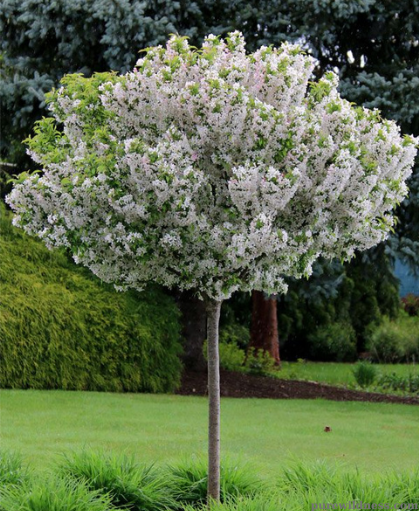
The Dwarf Crabapple ‘Coralburst’ offers an irresistible mix of beauty and practicality among dwarf flowering trees. Growing only 8–12 feet tall, this small ornamental tree dazzles with coral-pink buds that open into fragrant pale pink flowers in spring, followed by tiny orange fruits that persist into winter. The rounded, symmetrical shape and glossy green leaves provide visual interest throughout the year.
Native to North America, this cultivar thrives in full sun and well-drained soil in USDA zones 4–8. It’s also cold-hardy and easy to maintain, needing little pruning. In fall, its leaves turn golden-yellow, adding even more charm. Whether you plant it as a front-yard specimen, along a walkway, or in a container, the Dwarf Crabapple brings continuous seasonal appeal. Among dwarf flowering trees, few combine year-round color, fragrance, and structure as elegantly as this one.
14. Dwarf Smoke Tree (Cotinus coggygria ‘Young Lady’)
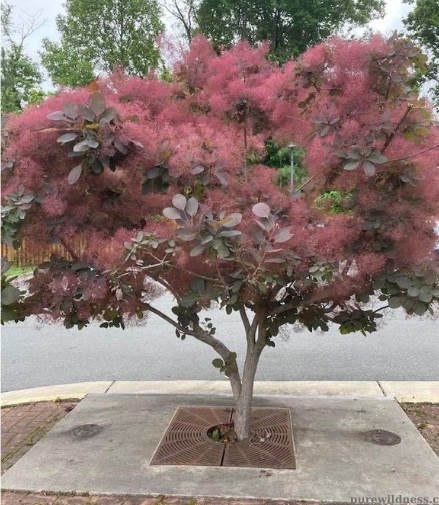
The Dwarf Smoke Tree ‘Young Lady’ adds a whimsical, almost magical touch to small landscapes. Native to southern Europe and central Asia, this tree grows only 4–6 feet tall, yet it delivers a cloud-like display of pale pink to purplish “smoke” blooms that appear in summer. These airy plumes rise above the foliage, giving the illusion of a soft mist drifting over the plant.
Its blue-green leaves turn brilliant orange, red, and gold in fall, extending its beauty through multiple seasons. Thriving in full sun and well-drained soil, it’s heat- and drought-tolerant once established. This compact version of the traditional smoke tree is perfect for urban gardens, courtyards, or mixed borders. With its ethereal look and manageable size, ‘Young Lady’ brings high visual impact to small spaces—truly one of the most unique dwarf flowering trees you can grow.
15. Dwarf Hydrangea Tree (Hydrangea paniculata ‘Bobo’)
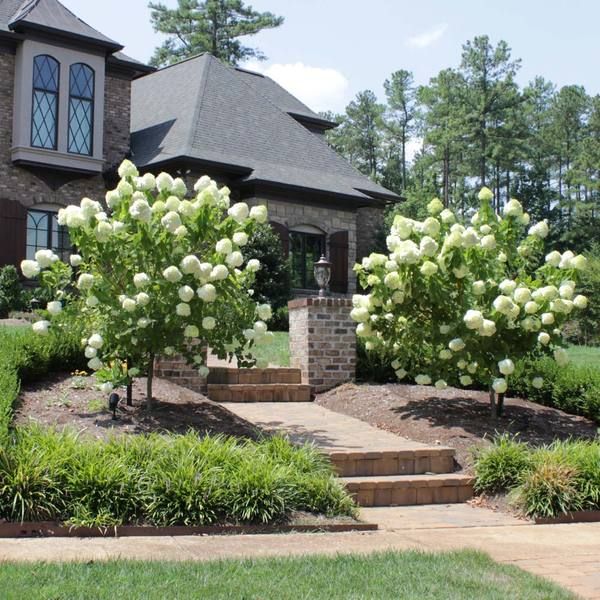
If you love lush, showy blooms but have limited space, the ‘Bobo’ Hydrangea Tree is your dream plant. A compact form of the classic panicle hydrangea, this beauty grows only 2–3 feet tall and 3–4 feet wide, yet it produces huge white flower clusters that cover the plant from mid-summer through fall. As the season progresses, the blooms blush soft pink and finally rosy red, extending the show into autumn.
Native to Asia, it thrives in full sun to partial shade and prefers moist, fertile, well-drained soil. Hardy in USDA zones 3–8, it tolerates cold winters and still blooms reliably each year. Its compact growth habit makes it perfect for small yards, patio containers, or foundation plantings. The Dwarf Hydrangea Tree proves that even the tiniest dwarf flowering trees can create grand, luxurious displays of color.
Conclusion
Each of these dwarf flowering trees brings its own unique beauty — from the fragrant blooms of the Dwarf Magnolia to the vibrant hues of the Crape Myrtle and the delicate petals of the Weeping Cherry. Though small in size, they carry an incredible presence, turning even the tiniest spaces into living works of art.
🌿 These dwarf flowering trees will help you create a garden that feels larger, brighter, and more alive. Whether you’re working with a compact backyard, a patio container, or a city courtyard, these trees offer color, texture, and fragrance through every season.
Low-maintenance yet endlessly charming, they invite butterflies, birds, and beauty right to your doorstep.
So plant one — or a few — and watch how your small garden transforms into a peaceful haven full of color and joy.
Because in the end, it’s not the size of your garden that matters, but the love and life you grow within it.
